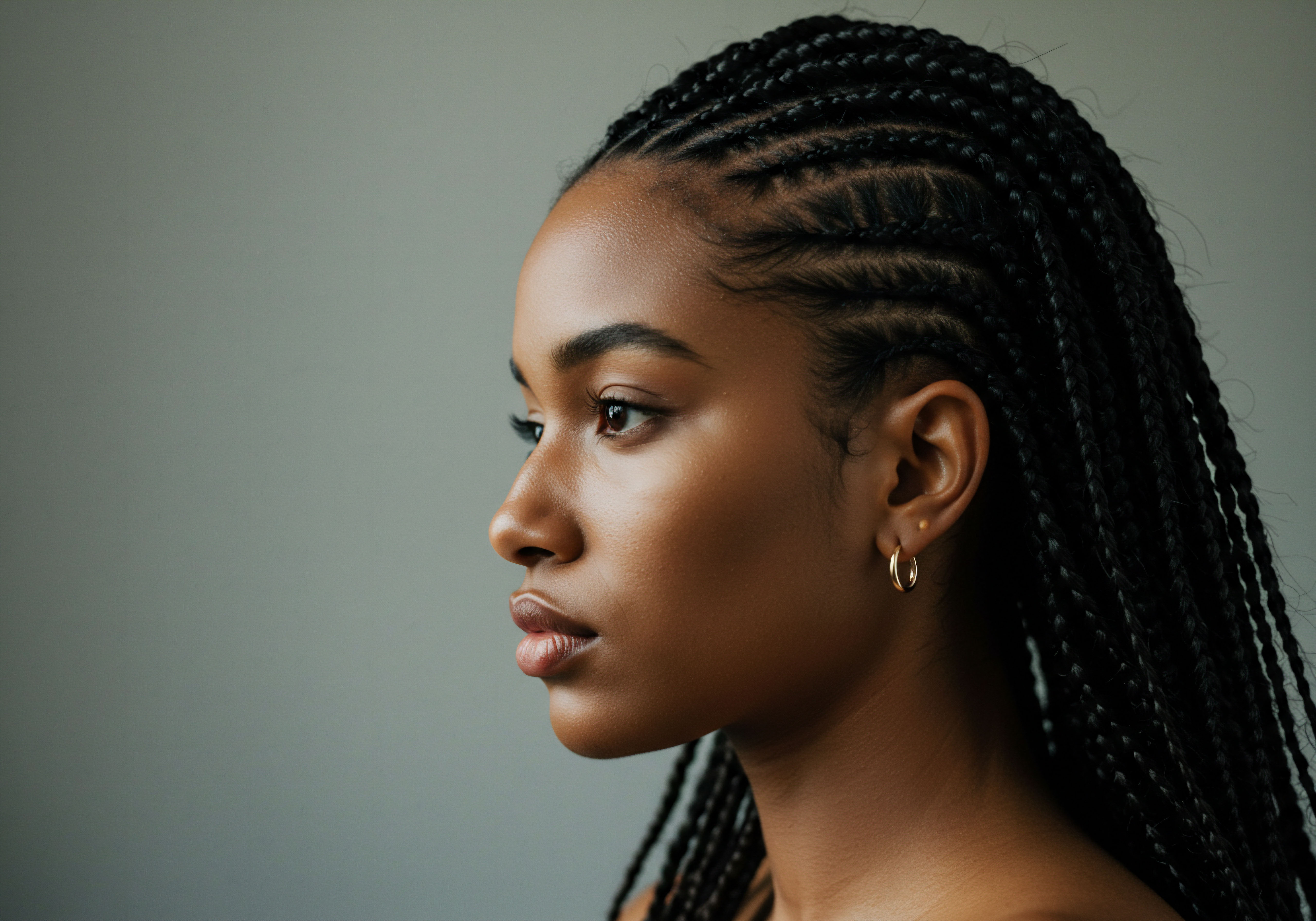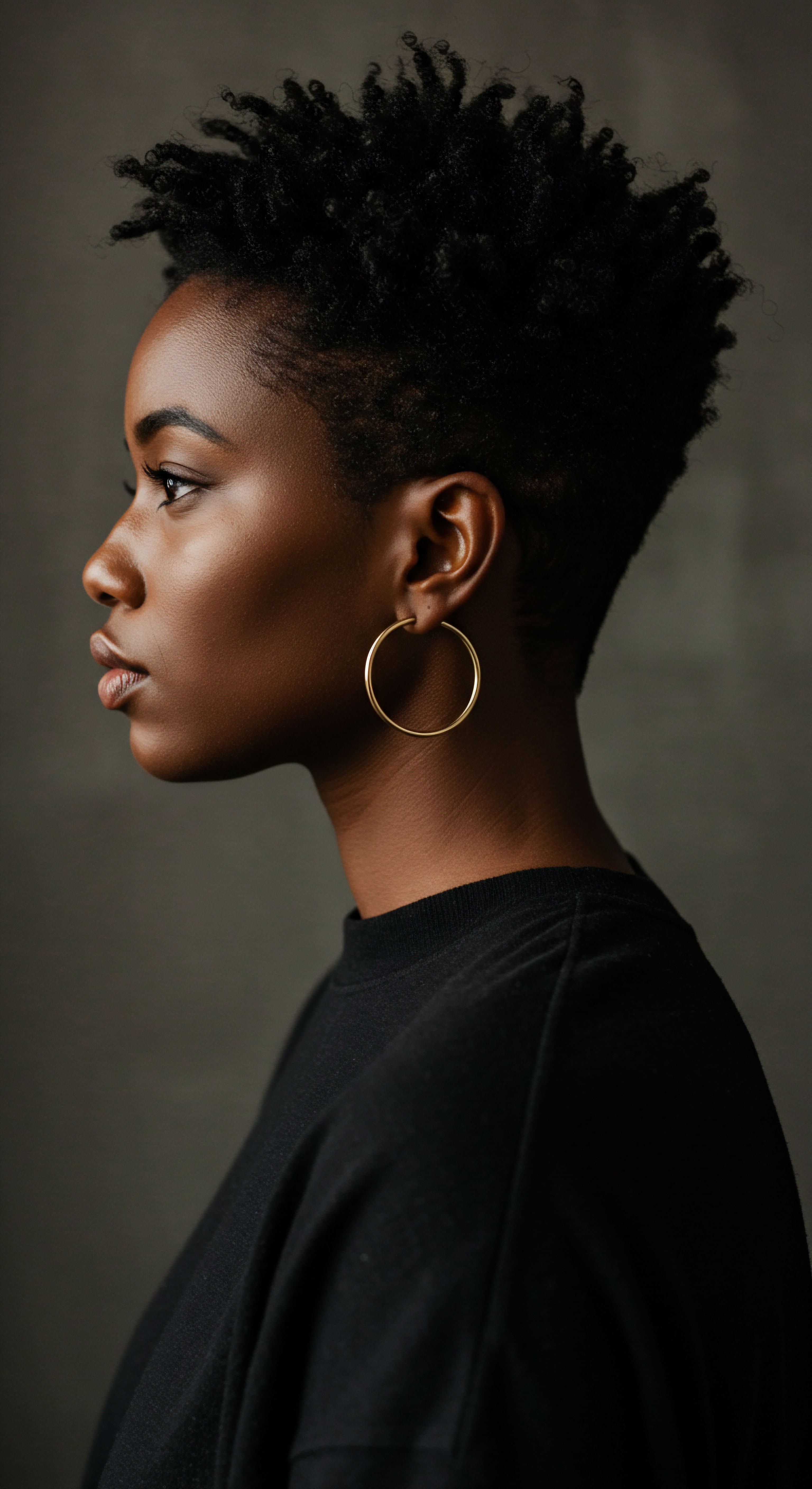
Fundamentals
The journey into understanding textured hair often begins with an appreciation for its inherent dynamism, a living testament to the subtle interplay of forces both within and around us. Here at Roothea, we propose a concept we call “Textured Hair Hormones,” a thoughtful interpretation of the profound biological rhythms and external life experiences that sculpt the distinctive characteristics of coils, curls, and waves. This is not merely a biological classification; rather, it is a comprehensive lens through which we can perceive the ongoing dialogue between our inner world and the outer environment, continuously shaping the hair that crowns us.
Consider this conceptualization as a gentle whisper from within, guiding the very form and resilience of each strand. Our hair, particularly textured hair, possesses a remarkable responsiveness to the shifts occurring throughout our lives. From the delicate changes of adolescence to the profound transformations of pregnancy or the graceful transition into later years, these internal milestones leave their subtle yet undeniable marks upon our hair. This understanding offers a deeper connection to our strands, allowing us to perceive them not as static elements, but as responsive extensions of our holistic well-being.
Textured Hair Hormones represent Roothea’s conceptual framework for understanding the intricate interplay of internal biological rhythms and external life experiences that shape the unique characteristics of textured hair.
At its simplest, the definition of “Textured Hair Hormones” speaks to the observable changes in hair texture, density, and growth patterns influenced by the body’s internal messengers and the broader environment. These internal messengers, often referred to as hormones in a traditional sense, orchestrate a delicate dance that impacts hair follicles. External influences, such as the foods we consume, the quality of our rest, and the presence of stress, also play a significant part in this complex communication. Acknowledging this intricate relationship allows for a more attuned approach to hair care, moving beyond surface-level solutions to address the underlying influences that contribute to hair health.
This perspective encourages a harmonious relationship with our hair, fostering an understanding that extends beyond product application. It recognizes that the vitality of textured hair is deeply intertwined with our overall health and lived experiences. By embracing this broader meaning, we begin to decode the nuanced language our hair speaks, learning to respond with informed care that truly nourishes its distinctive nature.

The Hair’s Responsive Nature
Hair, in its magnificent diversity, functions as a living archive, subtly recording the body’s internal narratives. For textured hair, this responsiveness is particularly pronounced, often revealing its stories through changes in curl pattern, porosity, or overall feel. The very formation of each hair follicle, a tiny organ nestled within the skin, is influenced by a symphony of biological signals from conception onward. These signals dictate not only the potential for hair growth but also its inherent shape, contributing to the glorious spectrum of waves, curls, and coils we celebrate.
Think of the hair follicle as a tiny, yet incredibly sophisticated, factory. Its output—the hair strand—is a direct reflection of the raw materials and operational instructions it receives. When these instructions are altered, even subtly, by internal biological shifts or external pressures, the resulting hair can tell a compelling story. This concept of “Textured Hair Hormones” encourages us to listen closely to these stories, providing a deeper interpretation of our hair’s needs.
Understanding this foundational aspect means acknowledging that a comprehensive approach to textured hair care transcends superficial treatments. It demands a holistic viewpoint, recognizing that the strands adorning our heads are not isolated entities, but rather integral components of our entire physiological and emotional landscape. This delineation of “Textured Hair Hormones” serves as a guiding principle for Roothea, emphasizing care that resonates with the body’s intrinsic wisdom.

Intermediate
Moving beyond the foundational conceptualization, the intermediate meaning of “Textured Hair Hormones” deepens our appreciation for the specific biological and environmental factors that shape textured hair’s journey. This interpretation focuses on the tangible ways hormonal fluctuations and lifestyle choices manifest within the unique structure of coils, curls, and waves, influencing everything from their growth cycles to their moisture retention capabilities. It provides a more detailed explanation of how these internal dialogues translate into the hair’s visible characteristics and daily care requirements.
Consider the body’s endocrine system, a network of glands secreting various chemical messengers, often termed hormones, into the bloodstream. These messengers travel throughout the body, influencing a multitude of processes, including hair growth and its characteristics. Androgens, for example, a group of hormones present in both men and women, play a well-documented role in regulating hair follicle activity. While often associated with hair loss in certain patterns, their presence also influences hair thickness and sebum production, factors that hold particular significance for textured hair types.
Estrogens, conversely, tend to promote longer anagen (growth) phases, contributing to hair density. The balance, or imbalance, of these internal chemical signals directly impacts the life cycle of each hair strand.
The intermediate understanding of Textured Hair Hormones illuminates how specific biological and environmental factors sculpt the distinct qualities of textured hair, from growth cycles to moisture dynamics.

Biological Influences on Textured Hair
The growth cycle of hair, encompassing anagen (growth), catagen (transition), and telogen (resting) phases, is profoundly influenced by hormonal directives. For individuals with textured hair, these cycles dictate not only the potential length of their strands but also the consistency of their curl patterns. Fluctuations in thyroid hormones, for instance, can lead to widespread thinning or changes in hair texture, often resulting in drier, more brittle strands that may be particularly noticeable in tightly coiled hair. Cortisol, the body’s primary stress hormone, when chronically elevated, can prematurely shift hair follicles into the resting phase, leading to increased shedding.
Pregnancy offers a compelling example of hormonal influence on hair. The surge in estrogens during gestation often extends the anagen phase, resulting in thicker, fuller hair for many individuals. Following childbirth, the sudden drop in these hormones can trigger a synchronized shedding, known as postpartum telogen effluvium.
For those with textured hair, this experience can be particularly pronounced, requiring thoughtful care and patience as the body rebalances. Similarly, the hormonal shifts associated with menopause can lead to changes in hair density and a perceived alteration in texture, as follicles may miniaturize and produce finer strands.
Understanding the impact of these hormonal shifts provides a valuable framework for navigating the evolving needs of textured hair throughout different life stages. It moves beyond a superficial concern for external appearance, delving into the underlying biological mechanisms that dictate hair health. This detailed delineation offers a practical clarification for those seeking to harmonize their hair care practices with their body’s internal rhythms.
- Androgens ❉ These hormones, including testosterone and dihydrotestosterone (DHT), influence hair follicle size and sebum production. Elevated levels can lead to follicle miniaturization and increased oiliness, impacting the delicate balance of textured strands.
- Estrogens ❉ Typically extending the hair’s growth phase, higher estrogen levels contribute to denser, often more lustrous hair. Declining estrogen, as seen in menopause, can lead to reduced hair density and altered texture.
- Thyroid Hormones ❉ Both hyperthyroidism and hypothyroidism can disrupt the hair growth cycle, resulting in diffuse thinning or changes in hair quality, making strands more fragile and prone to breakage.
- Cortisol ❉ Chronic elevation of this stress hormone can force hair follicles into a premature resting phase, leading to noticeable shedding. Managing stress becomes a critical component of maintaining hair vitality.

Environmental and Lifestyle Manifestations
Beyond internal biological messengers, the “Textured Hair Hormones” concept also encompasses the significant role of environmental and lifestyle factors. These external influences, though not hormones themselves, directly impact the body’s internal hormonal balance and the overall health of hair follicles. Nutritional intake, for instance, provides the essential building blocks for hair growth.
Deficiencies in vital nutrients like iron, zinc, or specific vitamins can disrupt the hair cycle and compromise strand integrity. A balanced diet, rich in diverse micronutrients, contributes directly to the robust health of textured hair.
The quality and duration of sleep also play a subtle yet profound role. Adequate rest allows the body to repair and regenerate, processes that extend to the hair follicles. Chronic sleep deprivation can elevate stress hormones, contributing to hair thinning.
Similarly, consistent hydration is paramount; water is essential for every cellular process, including those supporting hair growth and maintaining the elasticity of textured strands. The presence of pollutants or harsh environmental conditions can also tax the body, potentially influencing its internal equilibrium and manifesting as dryness or brittleness in hair.
| Factor Nutrition |
| Influence on Hair Provides essential building blocks for keratin production and follicle function. |
| Relevance to Textured Hair Supports elasticity, reduces breakage, and maintains curl definition, especially important for fragile textures. |
| Factor Stress Management |
| Influence on Hair Regulates cortisol levels, impacting hair growth cycles and inflammation. |
| Relevance to Textured Hair Mitigates stress-induced shedding (telogen effluvium) which can be more visible on dense, textured hair. |
| Factor Hydration |
| Influence on Hair Essential for cellular function and moisture retention within hair strands. |
| Relevance to Textured Hair Crucial for maintaining the natural moisture barrier of porous textured hair, preventing dryness and frizz. |
| Factor Sleep Quality |
| Influence on Hair Supports bodily repair and regeneration, including follicle health. |
| Relevance to Textured Hair Contributes to overall hair vitality and resilience, particularly important for maintaining the structural integrity of coils and curls. |
| Factor These factors, while not hormones themselves, significantly contribute to the overall hormonal and physiological environment that shapes textured hair health. |
For individuals with textured hair, understanding these intermediate influences provides a more holistic perspective on hair care. It encourages a shift from reactive treatments to proactive wellness, where daily habits become as important as the products applied. This broadened description of “Textured Hair Hormones” empowers individuals to make informed choices that truly honor their hair’s complex biological and environmental dialogue.

Advanced
At its most sophisticated articulation, “Textured Hair Hormones” transcends a mere biological explanation, revealing itself as a profound socio-biological and epigenetic construct. This advanced meaning offers a comprehensive interpretation, recognizing that the inherent characteristics and well-being of textured hair—particularly within Black and mixed-race hair heritage—are shaped not only by circulating biochemicals but also by the cumulative physiological imprints of lived experiences, historical contexts, and ancestral legacies. It posits that the ‘hormonal landscape’ of textured hair is a dynamic confluence of genetic predispositions, environmental stressors, and the profound, often unacknowledged, echoes of collective cultural journeys. This elucidation demands a deep dive into the theoretical, cultural, and scientific perspectives, drawing on contemporary research and scholarship to unveil the full significance of this concept.
This conceptual framework moves beyond a simplistic cause-and-effect, acknowledging the intricate, multi-layered influences that contribute to the unique phenotype and health challenges observed in textured hair. The interplay of biological predispositions, often genetically inherited, with the epigenetic modifications induced by long-term environmental exposures and psychosocial stressors, paints a far more complete picture. Such a perspective encourages a nuanced understanding, allowing us to perceive hair not just as a cosmetic attribute, but as a sentinel of systemic health and a repository of collective memory. This delineation challenges conventional narratives, prompting a more culturally attuned and scientifically rigorous examination of textured hair vitality.
“Textured Hair Hormones,” in its advanced meaning, is a profound socio-biological and epigenetic construct, where hair’s health reflects the cumulative physiological imprints of lived experiences, historical contexts, and ancestral legacies.

The Epigenetic Layer of Hair Identity
Epigenetics, the study of heritable changes in gene expression that occur without alterations to the underlying DNA sequence, offers a compelling dimension to the “Textured Hair Hormones” concept. While our genes provide the blueprint for hair texture and growth potential, epigenetic mechanisms act as molecular switches, turning genes on or off in response to environmental cues. These modifications can be influenced by diet, stress, exposure to toxins, and even psychosocial factors, potentially impacting hair follicle function across generations. For textured hair, particularly within communities with histories of systemic marginalization, this layer of understanding becomes particularly salient.
Consider the profound impact of chronic stress on the body’s hormonal system. The hypothalamic-pituitary-adrenal (HPA) axis, the body’s central stress response system, releases cortisol, a glucocorticoid hormone, in response to perceived threats. While acute stress responses are adaptive, prolonged activation leads to chronically elevated cortisol levels.
Research indicates that such sustained physiological stress can influence hair follicle cycling, potentially leading to premature entry into the resting phase and increased shedding, a condition known as telogen effluvium. For textured hair, this can exacerbate existing concerns like density or perceived thinning.
A study examining the association between perceived everyday discrimination and hair cortisol concentration (HCC) revealed a significant disparity. Research published in the journal Psychoneuroendocrinology indicated that African Americans exhibited higher HCC compared to White adults, even when both groups reported similar frequencies of perceived discrimination. This suggests that the physiological response to discrimination, reflected in cortisol levels, may be more pronounced or sustained in African American individuals. This finding is particularly impactful because hair cortisol provides a retrospective measure of chronic stress over weeks or months, offering a unique insight into long-term physiological burden.
This data point underscores a crucial, often overlooked, dimension of “Textured Hair Hormones” ❉ the deep, biological inscription of societal stressors on hair health. It highlights that the hair’s vitality is not solely a matter of individual biology or care practices, but is also inextricably linked to broader systemic realities and the cumulative physiological burden of racial discrimination. This is not merely an anecdotal observation; it is a scientifically measurable phenomenon where the very strands of hair bear witness to historical and ongoing societal pressures.
This perspective on “Textured Hair Hormones” compels us to consider the intergenerational implications of chronic stress and its biological signature. The concept of “weathering,” which describes the cumulative impact of chronic stress on health disparities over a lifetime, can extend to hair health. Epigenetic modifications, potentially influenced by these long-term stressors, could theoretically be passed down, subtly altering the hair follicle’s resilience or its response to future environmental cues. This complex explication of “Textured Hair Hormones” demands a shift in how we perceive and address hair health, moving towards interventions that acknowledge and mitigate systemic stressors, alongside targeted care.

The Interplay of Biological, Historical, and Social Factors
The advanced definition of “Textured Hair Hormones” further analyzes the profound impact of historical and social factors on hair, particularly within Black and mixed-race communities. For centuries, textured hair has been a site of cultural meaning, identity, and often, societal pressure. The legacy of beauty standards that historically favored straight hair has led to practices like chemical relaxing and excessive heat styling, which, while offering temporary conformity, can lead to chronic hair damage and specific forms of alopecia, such as Central Centrifugal Cicatricial Alopecia (CCCA). While CCCA’s etiology is multifactorial, encompassing genetic predispositions, the historical prevalence of damaging styling practices undoubtedly contributed to its widespread occurrence and often delayed diagnosis.
This complex interplay highlights how external pressures can lead to internal physiological responses that ultimately affect hair health. The stress of conforming, the physical strain of certain styling methods, and even the psychological impact of discrimination related to hair texture can collectively contribute to a chronic inflammatory state within the scalp, impacting hair follicle integrity. This understanding broadens the connotation of “hormones” to encompass not just biochemical signals, but the broader “hormonal environment” of the body, influenced by psychosocial realities. The very denotation of hair health in textured communities thus carries the weight of history and social context.
Understanding these profound connections is essential for developing truly effective and respectful hair care strategies. It moves beyond superficial solutions, addressing the deeper layers of influence that shape the vitality of textured hair. This specification of “Textured Hair Hormones” invites a more empathetic and comprehensive approach to textured hair care, recognizing its deep roots in personal and collective history.
- Genetic Predisposition ❉ Individuals with textured hair possess unique genetic markers that dictate curl pattern, density, and follicle shape. These predispositions form the biological foundation upon which other factors act.
- Epigenetic Modifications ❉ Environmental and psychosocial stressors can induce epigenetic changes, altering gene expression without changing the DNA sequence. These modifications may influence hair follicle resilience and susceptibility to damage.
- Chronic Stress and Inflammation ❉ Sustained exposure to stressors, including discrimination and societal pressures, elevates cortisol and inflammatory markers. This can disrupt hair cycles and contribute to conditions like telogen effluvium or exacerbate inflammatory alopecias.
- Cultural and Historical Practices ❉ Hair styling traditions, often influenced by societal beauty standards, can have long-term physical and psychological impacts on hair health. The legacy of these practices contributes to the overall “hormonal landscape” of textured hair.
The ultimate import of this advanced interpretation of “Textured Hair Hormones” is its call for a holistic and culturally competent approach to textured hair wellness. It demands that we consider the full spectrum of influences—from the microscopic activity within a follicle to the macro-level societal forces—that shape hair health. For experts and practitioners, this means moving beyond a singular focus on genetics or styling, to integrate insights from dermatology, endocrinology, psychology, and cultural studies.
The essence of this concept lies in its recognition that textured hair is not merely a biological phenomenon, but a complex, living testament to human experience, resilience, and identity. This sophisticated explication serves as a powerful guide for research, product development, and personalized care strategies that truly honor the unique journey of textured hair.

Reflection
As we journey through the intricate layers of “Textured Hair Hormones,” a profound realization unfolds ❉ our hair is far more than a simple adornment; it is a vibrant, living echo of our inner world and the broader currents of our existence. This concept, born from Roothea’s deep reverence for textured hair, encourages us to listen to the subtle whispers and sometimes louder declarations our strands make about our well-being. It invites a gentle curiosity, a willingness to explore the connections between our internal rhythms, the stories we carry, and the very vitality that emanates from our scalp.
The beauty of understanding “Textured Hair Hormones” lies in its capacity to transform our relationship with our hair from one of struggle or superficiality to one of profound connection and intuitive care. It empowers us to move beyond reactive measures, instead fostering a proactive dialogue with our bodies, informed by both scientific insight and ancestral wisdom. Each curl, every coil, and every wave becomes a testament to a complex, beautiful narrative—a narrative we are invited to understand, honor, and nourish with deep respect. This knowledge, therefore, becomes a grounding presence, light and airy yet rich with possibility, guiding us toward a more harmonious and truly radiant expression of self.

References
- 1. Byrd, A. D. & Tharps, L. L. (2014). Hair Story ❉ Untangling the Roots of Black Hair in America (Revised and Updated Edition). St. Martin’s Griffin.
- 2. Davis-Sivasothy, A. (2011). The Science of Black Hair ❉ A Comprehensive Guide to Textured Hair Care. SAJA Publishing Company.
- 3. Banks, I. (2000). Hair Matters ❉ Beauty, Power, and Black Women’s Consciousness. New York University Press.
- 4. Callender, V. D. & McMichael, A. J. (Eds.). (2011). Hair Loss Disorders in Women of Color ❉ A Guide to Diagnosis and Management. Springer.
- 5. Paus, R. & Cotsarelis, G. (1999). The Biology of Hair Follicles. New England Journal of Medicine, 341(7), 491-497.
- 6. Paus, R. & Cotsarelis, G. (2008). The Biology of Hair. CRC Press.
- 7. Arck, P. C. Handjiski, B. Peters, E. M. J. Peter, A. S. Hagen, E. Fischer, A. Klapp, B. F. & Paus, R. (2003). Stress inhibits hair growth in mice by induction of premature catagen development and deleterious perifollicular inflammatory events via neuropeptide substance P-dependent pathways. The American Journal of Pathology, 162(3), 803-814.
- 8. Herskovitz, I. & Miteva, M. (2016). Central centrifugal cicatricial alopecia ❉ challenges and solutions. Clinical, Cosmetic and Investigational Dermatology, 9, 175-185.
- 9. Callender, V. D. & Wright, D. (2021). Central Centrifugal Cicatricial Alopecia (CCCA) and Androgenetic Alopecia (AGA) ❉ Diagnostic and Treatment Approaches. Next Steps in Dermatology Conference Proceedings.
- 10. Jackson, M. & Steptoe, A. (2018). Race moderates the association of perceived everyday discrimination and hair cortisol concentration. Psychoneuroendocrinology, 97, 143-149.
- 11. Sinha, A. & Suresh, P. K. (2016). Epidermal Differentiation Complex ❉ A Review on Its Epigenetic Regulation and Potential Drug Targets. Cell Journal, 18(1), 1-6.
- 12. Miteva, M. & Tosti, A. (2013). Central centrifugal cicatricial alopecia. Dermatologic Therapy, 26(3), 209-216.
- 13. Palmer-Bacon, J. Willis-Esqueda, C. & Spaulding, S. (2019). Stress, Trauma, Racial/Ethnic Group Membership, and HPA Function ❉ Utility of Hair Cortisol. Journal of Black Psychology, 45(6), 481-504.